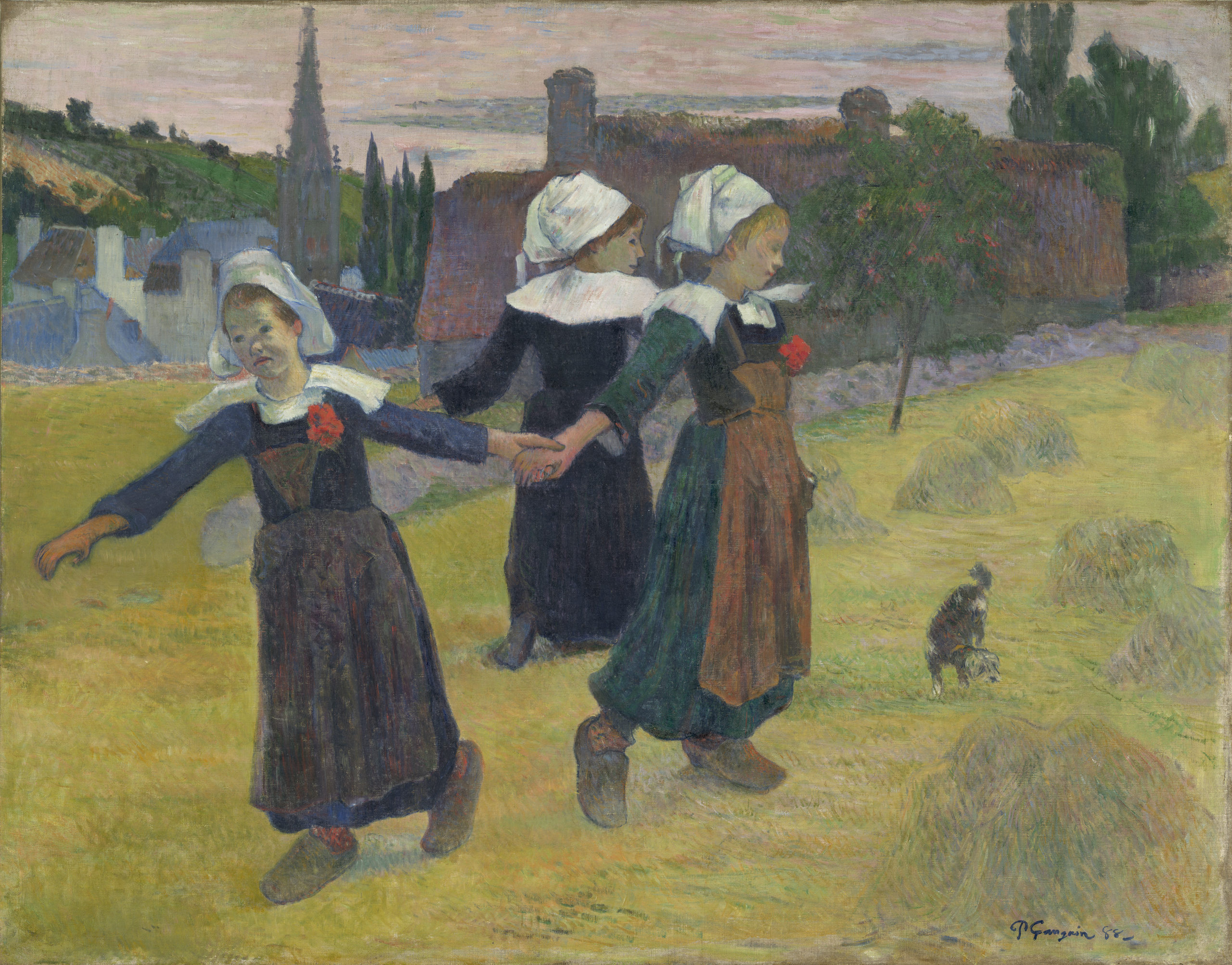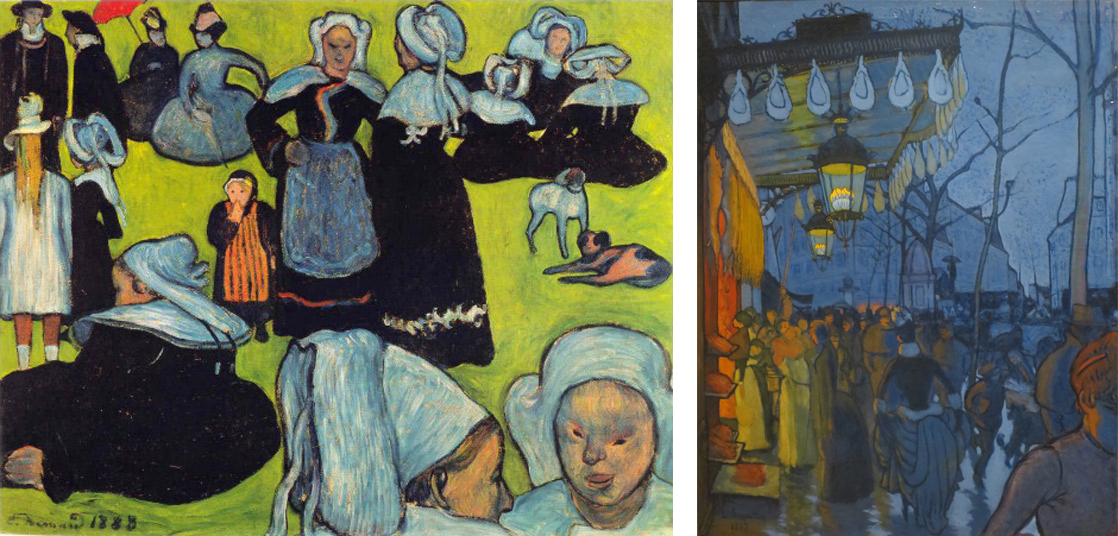
Poster for the Exhibition at the Café des Arts, 1889, lithograph; 28 x 39.7 cm (Pennsylvania State University Libraries, Rare Books and Manuscripts Special Collection)
 When the mirrors intended to decorate the walls of the Café des Arts in Paris did not arrive in time for its opening in 1889, the owner agreed to an improvised art exhibition instead. The artists, including Paul Gauguin, Emile Bernard, Charles Laval, and Emile Schuffenecker, called themselves the “Groupe Impressioniste et Synthétiste,” but they are better known today as the Pont-Aven School, after a town in the French province of Brittany where many of the artists painted.
When the mirrors intended to decorate the walls of the Café des Arts in Paris did not arrive in time for its opening in 1889, the owner agreed to an improvised art exhibition instead. The artists, including Paul Gauguin, Emile Bernard, Charles Laval, and Emile Schuffenecker, called themselves the “Groupe Impressioniste et Synthétiste,” but they are better known today as the Pont-Aven School, after a town in the French province of Brittany where many of the artists painted.
At the exhibition Gauguin showed a painting of three Breton girls dancing in a meadow outside of Pont-Aven, with the steeple of St. Joseph’s church in the background. This painting exhibits two key characteristics of the Pont-Aven School: “primitivist” themes featuring rural and peasant subject matter, and a “synthetist” style consisting of simplified drawing, clearly-defined contours, intensified colors, and flattened space.

Paul Gauguin, Breton Girls Dancing, 1888, oil on canvas, 73 x 92.7 cm (National Gallery Washington DC)
“The land of the painter”
Brittany had been a popular destination for tourists since the first railway line from Paris was completed in the 1860s. It was famous not only for its rugged landscape but also for its picturesque inhabitants, especially the Breton peasant women in their starched white caps. A popular English guidebook of the time titled Breton Folk described Brittany as “the land of the painter,” and it commended the region’s particular attraction for artists “in search of picturesque costume and scenes of pastoral life.” [1]
Rustic and peasant subjects were popular with French artists and patrons starting with the Barbizon School and French Realist painters of the mid-nineteenth century. Such “timeless” rural scenes offered a reassuring sense of tradition and continuity during a time marked by rapid industrialization and urbanization.

Pascal Dagnan-Bouveret, Breton Women at a Pardon, 1887, oil on canvas, 125.1 x 141.1 cm (Museu Calouste Gulbenkian, Lisbon)
Pascal Dagnan-Bouveret’s Breton Women at a Pardon, shown in the French Salon of 1889, demonstrates the popularity of Breton subjects in a conventional Academic style. It shows a group of Breton peasants gathered in the foreground listening to a woman read. The background depicts a characteristic Breton ritual called a Pardon, in which penitents process barefoot or on their knees around the church to earn absolution for their sins. To a middle-class urban viewer, the Breton peasants would have seemed quaint and old-fashioned, but also admirable for their piety and authenticity.
Synthetism

Paul Gauguin, Vision after the Sermon (or Jacob Wrestling with the Angel), 1888, oil on canvas, 72.20 x 91.00 cm (National Gallery of Scotland, Edinburgh)
Like Dagnan-Bouveret’s painting of the previous year, Gauguin’s famous Vision after the Sermon also depicts the profound religious faith of the Breton people. A group of women in the foreground file out of church, having just heard a sermon on Jacob wrestling an angel (Genesis 32:24-32). So great is their faith that they literally “see” the Biblical scene in front of the church, right next to a prosaically grazing cow.
The style of the two works is very different, however. Gauguin’s color is bright and unnatural compared to Dagnan-Bouveret’s muted grays and earth tones, and next to the Academic artist’s meticulous naturalism Gauguin’s technique appears downright incompetent. The drawing is crude, the anatomy of the women’s faces is almost childish, the flat planes of their clothing utterly fail to convey a sense of the bodies underneath, and the red ground stands up like a wall rather than receding into space.
Far from incompetent, however, Gauguin’s simplified, even somewhat crude, technique was a conscious choice. A young artist named Paul Sérusier who studied with Gauguin recounted the older artist’s advice while they were out painting together on the bank of a river near Pont-Aven:
How do you see these trees? They’re yellow; so put some yellow. This shadow, it’s rather blue, paint it with pure ultramarine. Those red leaves? Put vermillion. [2]
Gauguin tells Sérusier to both simplify and intensify what he is seeing. Rather than seeking subtle nuances of color and tone within the yellowish autumn leaves, Sérusier paints them in pure, unmodulated yellow. The cool gray trunks of the trees are similarly rendered as strokes of ultramarine mixed with white, against a background of vermilion red. Each color is intensified, and the drawing and composition are simplified into a flat pattern. Elsewhere, Gauguin advised artists to paint from memory rather than directly from nature, because memory automatically discards extraneous detail and distills perceptions down to their essence.

Left: Paul Gauguin, Breton Girl and Goose by the Water, 1888, oil on canvas, 25.1 x 39.4 cm (private collection); right: Paul Signac, The Bathing Cabins, Opus 185 (Beach of the Countess), 1888, oil on canvas, 33.3 x 46.4 cm (Nelson-Atkins Museum of Art)
This process of distilling multiple, complex elements into a simplified whole is what the group meant when they called themselves “Synthetists” at the Café des Arts exhibition. Insisting on the process of synthesis was a deliberate contrast to the highly scientific and analytic process of Neo-Impressionism. The two paintings above were executed in the same year just a few miles apart in Brittany. Whereas the Neo-Impressionists worked to analyze or carefully break down all the separate components that make up complex color sensations and then rendered them in innumerable tiny dots, the Synthetists distilled them into broad areas of pure color.

Left: Emile Bernard, Breton Women in the Meadow, 1888, oil on canvas, 74 x 92 cm (private collection); Right: Louis Anquetin, Avenue de Clichy, le soir, cinq heurs, 1887, watercolor and gouache on paper (private collection)
The Synthetist style was sometimes called “Cloisonnism,” after the cloisonné technique used to decorate objects by melting colored enamel between wire outlines. It also has similarities to Japanese prints, which were popular at the time, as well as Medieval colored woodcuts and stained glass. Synthetism was somewhat antithetically associated with both sensual/decorative qualities and religious/spiritual qualities, but whatever its genesis or purpose, it forms a sharp contrast to both the Academic naturalist style of Dagnan-Bouveret and the Neo-Impressionist style of Signac.
Primitivism

Left: Paul Gauguin, The Yellow Christ, 1889, oil on canvas, 91.1 x 73.4 cm (Albright-Knox Art Gallery); Right: Anonymous, Crucifix, Notre-Dame de Trémalo Chapel, Pont-Aven, 17th century, wood and polychrome (photo: © Yann Gwilhoù, CC-BY-SA 3.0)
There is a logic in depicting peasant life with this simplified style. The bright colors and crude drawing of Synthetism have much in common with rural folk art. Gauguin implicitly acknowledges this similarity of style in his painting The Yellow Christ of 1889, which shows a group of Breton women kneeling in prayer around a wooden crucifix in a field. The crucifix is a representation of one by an anonymous seventeenth-century artist that Gauguin saw a small chapel set in the fields outside of Pont-Aven. Although the work’s crude carving and stiff anatomy do not demonstrate technical facility, they seem to guarantee the simple and sincere faith of the anonymous sculptor who created it.
Instead of setting the crucifix in the chapel, Gauguin transports it into a field to further connect Christ’s life to the timeless cycles of nature that drive the traditional lives of Breton peasants. The light in the sky marks the time as early evening, and the color of the foliage denotes fall. Both suggest an ending, but an ending that holds promise of a new beginning. Christ, just like the sun and the fall harvest grains, will rise again.

Paul Gauguin, The Green Christ or Breton Calvary, 1889, oil on canvas, 92 x 73 cm (Royal Museums of Fine Arts of Belgium)
Both the simplified folk style and the peasant subject matter exemplify primitivism, a turning backwards to an earlier way of life (pre-industrial, pre-scientific, and pre-urban) as a way of seeking greater authenticity and a higher purpose in life. Gauguin wrote in a letter to his friend Emile Schuffenecker, “I love Brittany. I find a certain wildness and primitiveness here. When my clogs resound on this granite soil, I hear the dull, matte, powerful tone I seek in my painting.” [3] Unlike Dagnan-Bouveret, who represented Breton folk life with the sophisticated technique and scientific eye of a thoroughly modern Parisian, Gauguin aspired to “go primitive,” as exemplified by his adoption of peasant clogs (sabots) as well as the simple folk-art style of his paintings.
Authenticity or fantasy?
It is easy to romanticize the Pont-Aven School’s project of celebrating the simple rural life and folk traditions of the Breton peasants. Many tellings of Gauguin’s biography eulogize his act of giving up a career as a stockbroker, along with all of the pleasures and conveniences of modern life, in order to live as poor painter among the peasants of Brittany and later on the South Sea island of Tahiti.
More recent scholarship has problematized both that biography and that project, however. The vision of Pont-Aven in Gauguin’s paintings is largely a romantic fantasy. Brittany was rapidly modernizing, and the folk traditions and costumes that Gauguin admired were vanishing or put on display only for holidays and tourists. The 1880 guidebook already notes that
In the shops and on the promenades [of Brittany] the majority of women are dressed as in Paris … Every year more white caps are thrown aside … and each year the markets of St. Malo and St. Servan have less individuality of costume. [4]
Gauguin’s paintings of Brittany are, in the end, more fantasies than accurate images of an authentic peasant culture.

Paul Gauguin, Vision after the Sermon (or Jacob Wrestling with the Angel), 1888, oil on canvas, 72.20 x 91.00 cm (National Gallery of Scotland, Edinburgh)
It is also worth asking why the main protagonists of Gauguin’s paintings are women, both in Brittany and later in Tahiti. In Vision after the Sermon as in The Yellow Christ and The Green Christ, it is women whose quaint costumes provide the antithesis to modern fashionability, women whose profound religious faith provides the antidote to modern science and skepticism, and women whose adherence to tradition provides a respite from the constant, disruptive innovations of modern life. While this does elevate women to a place of honor, it also reinforces commonplace stereotypes, suggesting that women preserve the faith and folk traditions simply because they are less suited than men to the new world of science, technology, and constant change.



